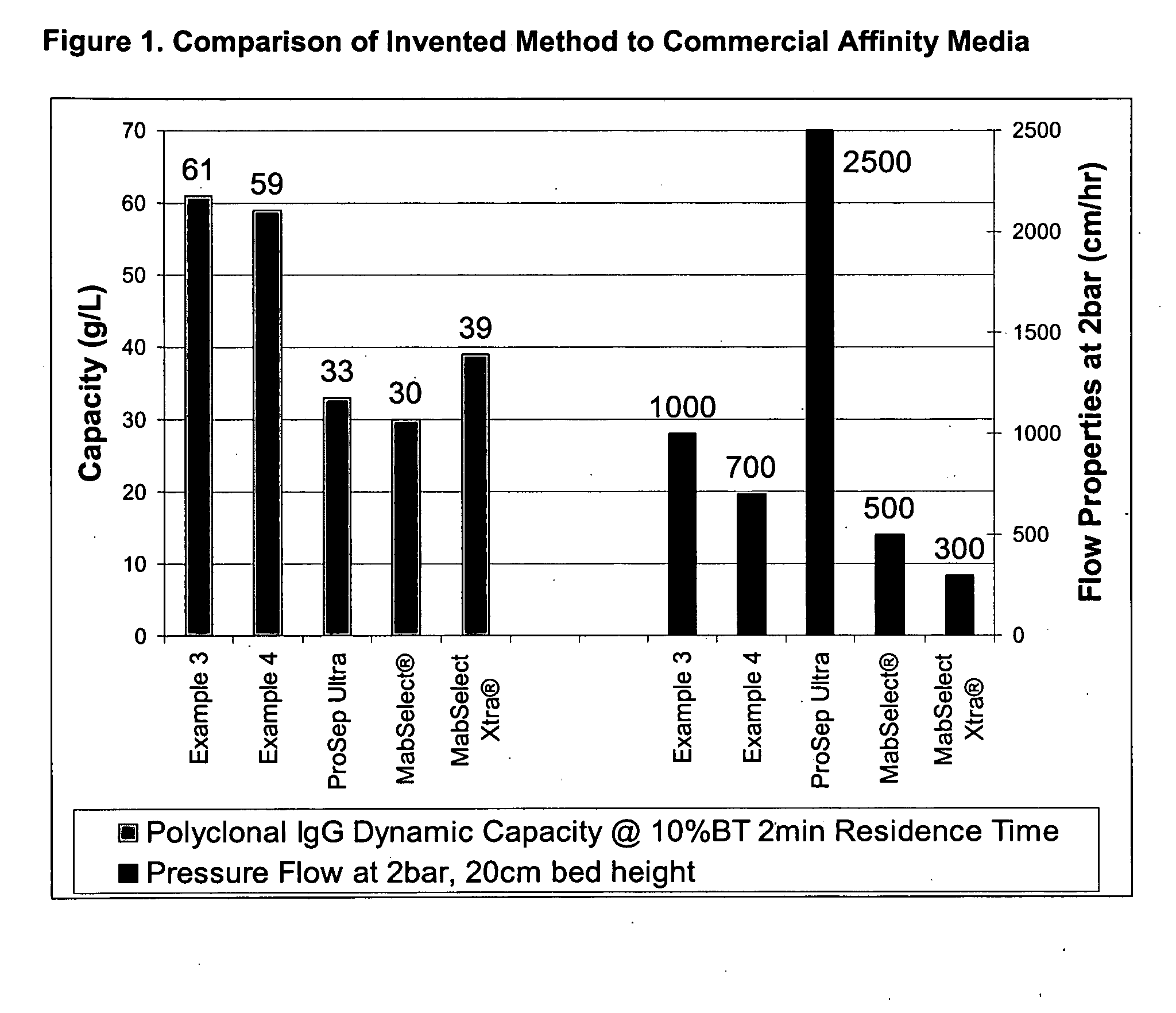Media for affinity chromatography
- Summary
- Abstract
- Description
- Claims
- Application Information
AI Technical Summary
Benefits of technology
Problems solved by technology
Method used
Image
Examples
example 1
Silica Affinity Matrix with Different Pore Sizes
[0046]Controlled pore glass beads (50 mL each, mean particle size of 63 μm) with pore sizes ranging from 500 Å to 1200 Å were functionalized with Protein A according to the method for coupling Protein A to a solid support described in WO 90 / 09237. A Protein A ligand density of 12-14 g / L was attained. After ligand coupling, the samples were washed three cycles with 150 mL volume of each (in order): 0.1 M Tris with 0.15M NaCl, pH 8 followed by 0.05M Acetic Acid. Afterwards, the samples were equilibrated and stored in PBS w / azide. The samples were tested for dynamic IgG binding capacity at 2 min flow residence time as described in Example 5 below. The properties for the affinity matrix of different pore sizes are shown in Table 1.
TABLE 1Properties of Silica Affinity matrix with different pore sizesCPG Pore SizeQd10% BT (g / L)489 Å22629 Å50700 Å54782 Å60839 Å61889 Å60932 Å581034 Å 451175 Å 46
example 2
Silica Affinity Matrix with Different Particle Sizes and Particle Size Distributions
[0047]Controlled pore glass beads (700 Å pore size, 50 mL each) with the described mean particle size (measured by light scattering) were functionalized with Protein A according to the method for coupling Protein A to a solid support described in WO 90 / 09237. A Protein A ligand density of 12-14 g / L was attained. After ligand coupling, the samples were washed three cycles with 150 mL volume of each (in order): 0.1 M Tris with 0.15M NaCl, pH 8 followed by 0.05M Acetic Acid. Afterwards, the samples were equilibrated and stored in PBS w / azide. The samples were tested for dynamic IgG binding capacity at 2 min flow residence time as described in Example 5 below. The properties for the affinity matrix of different pore sizes are shown in Table 2.
TABLE 2Properties of Silica Affinity matrix withdifferent particle size distributionsMean Particle SizeExample(μm)Qd10% BT (g / L)2.167492.265492.364512.462522.56153...
example 3
Silica Affinity Matrix Properties with 65 um Particle Size and Particle Size Distribution and 840 Å Pore Size
[0048]Controlled pore glass beads (839 Å pore size, 63 μm mean particle size, 50 mL volume) was functionalized with Protein A according to the method for coupling Protein A to a solid support described in WO 90 / 09237. A Protein A ligand density of 13 g / L was attained. After ligand coupling, the samples were washed three cycles with 150 mL volume of each (in order): 0.1M Tris with 0.15M NaCl, pH 8 followed by 0.05M Acetic Acid. Afterwards, the samples were equilibrated and stored in PBS w / azide. The samples were tested for dynamic IgG binding capacity as described in Example 5. The properties for this affinity matrix is shown in FIG. 1.
PUM
| Property | Measurement | Unit |
|---|---|---|
| Pore size | aaaaa | aaaaa |
| Pore size | aaaaa | aaaaa |
| Pore size | aaaaa | aaaaa |
Abstract
Description
Claims
Application Information
 Login to View More
Login to View More - R&D
- Intellectual Property
- Life Sciences
- Materials
- Tech Scout
- Unparalleled Data Quality
- Higher Quality Content
- 60% Fewer Hallucinations
Browse by: Latest US Patents, China's latest patents, Technical Efficacy Thesaurus, Application Domain, Technology Topic, Popular Technical Reports.
© 2025 PatSnap. All rights reserved.Legal|Privacy policy|Modern Slavery Act Transparency Statement|Sitemap|About US| Contact US: help@patsnap.com

